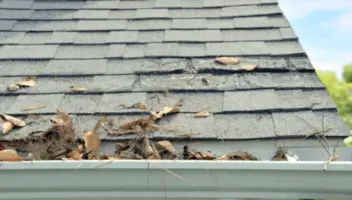The short answer is yes, gutter guards need to be cleaned out. However, they don’t need to be cleaned out as often as gutters without gutter guards.
Gutters are a critical element of your home’s overall structure and function. They funnel rain and snow runoff away from the base of your house. If your gutters aren’t working properly, your home is at risk of water damage, and the landscape around your home, including your driveway, could erode.
Gutter guards fit over your existing gutters to help keep debris out. This helps ensure adequate water flow and reduces the need to clean out your gutters.
Gutter guards need to be cleaned out to provide optimal drainage. In this post, we’ll guide you through gutter maintenance, why it’s important, and how to clean your gutter guards.
In this article:
- What Are Gutter Guards?
- Types of Gutter Guards
- The Importance of Gutter Maintenance
- Gutter Guards Need to be Cleaned Out
- Tools & Safety Equipment Checklist
- How Do You Clean Gutter Guards (5 Steps)
- Cost Analysis: DIY vs. Professional Maintenance
- Frequently Asked Questions
What Are Gutter Guards?
Gutter guards fit over your existing gutters to help keep debris out. This helps to ensure adequate water flow and can reduce the need to clean out your gutters. Gutter guards may also improve the lifespan of your gutters.
By reducing the amount of debris buildup in the gutter, a gutter guard system can reduce the breakdown of your gutters. Over time, water and debris can erode your gutters, which makes them less effective and could eventually lead to a costly (and premature) need for replacement.
Types of Gutter Guards
Gutter guards are designed to help keep leaves, twigs, and other debris out of your gutters while still allowing water to flow through. While they all aim to reduce clogs and minimize maintenance, each type performs differently depending on your climate, tree coverage, and roof design.
Here’s a breakdown of the five most common types of gutter guards, including how they work and what kind of upkeep they require.
Gutter Guard Comparison: Maintenance at a Glance
| Type | Ease of cleaning | Tools you’ll need | Removal required? |
|---|---|---|---|
| Foam | Moderate. The foam blocks debris but also holds it inside the pores, so plan to rinse and replace every few years. | Ladder, gloves, garden hose or low-pressure washer | Yes. Lifting the inserts out lets you flush them thoroughly. |
| Brush | Moderate to difficult. Bristles trap pine needles and seeds, which can be stubborn to shake loose. | Ladder, gloves, garden hose or pressure washer | Yes. Removing the brushes makes it easier to shake out debris and rinse clean. |
| Screen | Easy. Most leaves sit on top and hose off quickly, though screens can lift in strong winds. | Ladder, gloves, garden hose | Usually. Popping the panels off lets you clear anything that fell into the gutter beneath. |
| Mesh / Micro-Mesh | Moderate. Fine openings stop shingle grit and pollen but can gather on the surface, so a light brush or rinse twice a year keeps water flowing. | Ladder, gloves, soft-bristle brush, garden hose | Sometimes. Plastic mesh often lifts out; metal mesh is usually fixed in place. |
| Surface Tension (Reverse Curve) | Easy. Most debris slides away on its own; a quick rinse now and then is plenty. | Ladder, soft brush, garden hose | No. These systems stay mounted and are cleaned from above. |
The Importance of Gutter Maintenance
Homeowners may tend to overlook gutters, but they serve an important purpose for home safety, and should be regularly maintained to minimize damage risk and potential additional costs.
Fire Protection
Clogged gutters may increase the chances of flying embers from a wildfire igniting a fire in your gutters. Listed as one of the many ways to harden your home to help prevent wildfire spread, maintaining your gutters by removing excess debris like twigs, leaves, and moss can help reduce the risk.
Help Prevent Insect Infestation
Bugs love debris-filled gutters. They are often attracted to damp environments, making moisture-heavy clumps of leaves in your gutters a great place to congregate. Without routine gutter cleaning, insects like wasps, ants, cockroaches, and even termites might decide to move in.
Help Prevent Water Damage
Damaged gutters may also leak or sag, therefore failing to divert water away from your home. This can lead to rotted soffit and fascia, damaged shingles, mold and mildew growth, a flooded basement, or even damage to your driveway. Gutter guards help reduce the amount of debris entering the gutters while allowing water to flow through effortlessly.
Save Money and Time
On average, a gutter system will last anywhere from 10 to 20 years – but only if it is properly maintained. Regularly maintaining your gutters may take a little time, but it can save you a lot of time and money in the long run. A bit of maintenance now can help prevent the costly process of having to install new gutters sooner than necessary.
Believe it or not, strong gutters are your home's first line of defense against fires! LeafFilter's flame-resistant uPVC frame withstands heat, keeping you safe. Discover more on house fire prevention here: https://t.co/ny2wmR2Jx5 🔥 #WildFires #HardenYourHome #SafetyFirst pic.twitter.com/n22wDfjdTQ
— LeafFilter Gutter Protection (@LeafFilter) September 18, 2023
Gutter Guards Need to be Cleaned Out
Gutter guards are designed to prevent clogs from forming inside your gutters, but some types of gutter guards require more cleaning and maintenance than others. There are several types of gutter guards, including brush, foam, screen, mesh, and surface tension, and the level of effectiveness varies from one to the next.
The more effective the gutter guard is, the less cleaning and maintenance involved. However, regardless of the type of gutter guard that is on your gutters, we recommend cleaning them out at least once or twice a year to ensure the best performance. With micromesh gutter guards, this is as simple as brushing off any debris that accumulates on the top of the micromesh screen. However, if debris has gotten underneath—or if your mesh is plastic and removable—you may need to lift the guards to clean more thoroughly.
Signs That Gutter Guards Need to be Cleaned Out:
- Excessive debris is clogging the guards.
- Gutters are starting to sag.
- Plants are growing inside the gutter guards.
- Pests are hanging out in the gutters.
- Water is accumulating in the gutters.
Cleaning Tools & Safety Equipment Checklist
Ladder with stabilizer: A sturdy ladder with a stabilizer keeps you balanced and helps prevent accidents. It also spreads pressure more evenly, which helps protect your gutters and siding from dents or scratches while you work at height.
Work gloves and safety goggles: Gloves protect your hands from sharp edges and gutter buildup, while goggles or glasses shield your eyes from debris or splashback during cleaning.
Soft-bristle brush or gutter scoop: These help remove leaves, dirt, and grime without damaging your gutter guards or the gutters themselves.
Garden hose or pressure washer (low setting): Water pressure flushes out lingering debris and helps check that water is flowing freely through the gutters and downspouts.
Gutter cleaning brush with extension pole (optional): Ideal for ground-level cleaning, this tool helps you brush away debris on top of guards without climbing a ladder. This is especially useful for single-story homes.
How Do You Clean Gutter Guards (5 Steps)
We believe that everyone deserves top-notch gutter protection without breaking the bank.💰 With LeafFilter, you can say goodbye to clogged gutters and hello to savings! Check out our pricing here: https://t.co/PlQg9QglQw pic.twitter.com/zKJZRk0zu9
— LeafFilter Gutter Protection (@LeafFilter) July 31, 2023
Given the range of gutter guard styles available, how you clean them depends on the type. Brush and surface tension (reverse curve) gutter guards should be removed and cleaned manually since debris can still get lodged in these types of guards. Screen, foam, and some mesh gutter guards can be rinsed off with a hose but may also need to be removed for adequate gutter cleaning.
The following steps walk you through how to clean gutter guards with a fine mesh screen.
- Be Prepared: Prep the area around your home where the gutters are located using a tarp or ground covering to protect the landscaping. Prioritize safety by wearing proper footwear, safety goggles, and gloves. If you need to use a ladder, be sure to secure it carefully and follow ladder safety practices.
- Remove Excess Debris: Remove any excess debris that’s sitting on top of the gutter guard.
- Rinse the Guard and Gutter: Rinse off the mesh screen guard using a hose. Aim the nozzle toward the downspouts to help direct the water as you clean the screen.
- Scrub Away Stubborn Dirt: Using a soft-bristled brush, lightly scrub away any stuck-on dirt or debris still resting on top of the mesh screen.
- Rinse the Guard and Gutter: Repeat your rinse procedure to clean off the mesh screen again.
If your mesh guards are removable (especially plastic styles) you may need to lift them off once or twice a year to clean the gutters underneath. For deeper seasonal cleanings, it’s often best to call a professional.
For a twice-a-year deep cleaning of your gutters, it’s wise to call a professional to come take care of it.
Cost Analysis: DIY vs. Professional Maintenance
DIY gutter maintenance can be relatively low-cost upfront, especially if you already own basic tools like a ladder, gloves, and a hose. Most homeowners spend between $20 and $100 on additional tools such as a gutter scoop, soft-bristle brush, or extension pole. While DIY can be budget-friendly, it often requires a significant time commitment and physical effort, especially if you’re dealing with hard-to-reach areas or removable guards.
Cleaning gutters with guards can take several hours, especially if removal and reinstallation are required. While this approach may work for those comfortable on a ladder, it does carry safety risks and often needs to be repeated multiple times a year, depending on your guard type and tree coverage.
Professional gutter cleaning typically ranges from $200 to $400 annually for an average-sized home, with costs varying by location and roof accessibility. While this adds up over time, it eliminates the physical risk and ensures your system is functioning properly.
Choosing a high-performance gutter guard system like LeafFilter can also reduce how often maintenance is needed. LeafFilter’s professionally installed micro-mesh system is designed to block even the smallest debris and comes with a transferable lifetime warranty.
With fewer cleanings and better long-term protection, LeafFilter offers peace of mind and can actually save homeowners money over time by minimizing clogs, water damage, and frequent service calls.
Explore LeafFilter’s Gutter Protection System.
Frequently Asked Questions
Can you clean gutter guards with a pressure washer?
Yes, but it depends on the type of gutter guard. A low-pressure setting (around 2600 PSI or less) works well for foam or brush-style guards, where debris can get stuck deep inside. For mesh, screen, or surface tension systems, it’s better to use a garden hose and a soft brush to avoid damaging the material or loosening the guard. When in doubt, start with a gentler method or contact a professional.
Do gutter guards get clogged?
Yes, gutter guards can get clogged with debris like leaves and twigs, which need to be cleaned a few times a year to prevent clogs and damage.
What is the life expectancy of gutter guards?
The type of gutter guard determines its life expectancy. Foam gutter guards last about two years on average, while micromesh can last up to 20 years. Guards made of plastic can last between three and six years, and aluminum can last between 10 and 20 years.
How often should I inspect gutter guards for maintenance?
Gutter guards should be inspected and cleaned at least once or twice yearly. However, they should be cleaned if you notice debris buildup or other maintenance issues.
Can gutters get clogged with gutter guards?
Gutter guards are intended to keep unwanted items out of your gutters so water runs through them without an issue. However, they can become clogged if debris builds up on top of the gutter guard system and the water cannot easily pass through them.
Is there a downside to gutter guards?
DIY gutter guards can often cause problems, and cost may be a factor for some people. That’s why investing in quality micromesh gutter guards, which require the least maintenance, and having your guards professionally installed is important. Our proven gutter protection system can help lengthen the life of your existing gutters and add value to your home.
How do you clean under gutter guards?
Certain types of gutter guards have to be removed to clean out gutters and underneath the guards. This is a good time to call a professional gutter cleaner to ensure the job gets done correctly and safely.
LeafFilter® gutter guards use patented micromesh technology that blocks even small debris to help keep your gutters clog-free so you won’t have to worry about frequent gutter cleaning. With our low-maintenance gutter system, we recommend cleaning at least twice a year for any potential debris buildup in the spring and fall.
See all LeafFilter gutter guard locations and find the service location nearest you.
When is the best time of year to clean out your gutters?
The best time to clean out your gutters depends on your local climate and how much debris tends to build up around your home. Most homeowners benefit from cleaning their gutters twice a year, once in the spring and again in the fall. However, if your home is surrounded by trees, experiences frequent storms, or sees heavy snowfall, more frequent maintenance may be needed. Use the seasonal guide below to stay ahead of clogs and protect your home year-round.
Spring
As snow melts and trees begin to bloom, gutters can fill with roof grit, pollen, and early-season debris. A spring cleaning helps reset your system after winter and prepares it for summer rain.
Summer
Storms and high winds can push leaves, sticks, and debris into your gutters. In dry regions, this buildup may also become a fire hazard. A quick inspection during mid-summer helps ensure water can flow freely.
Fall
This is often the most important cleaning of the year. Falling leaves and pine needles can quickly clog your gutters and downspouts. Cleaning in late fall, after the last big leaf drop, helps prevent overflow.
Winter
If you experience heavy snow, check your gutters after major storms to keep things flowing.
Climate-Based Recommendations
- Heavily wooded areas: Clean three to four times a year, including after big storms.
- Dry or desert regions: Clean once or twice a year, and inspect after windstorms.
- Rainy or coastal areas: Clean three times a year, such as in spring, fall, and mid-rainy season.


